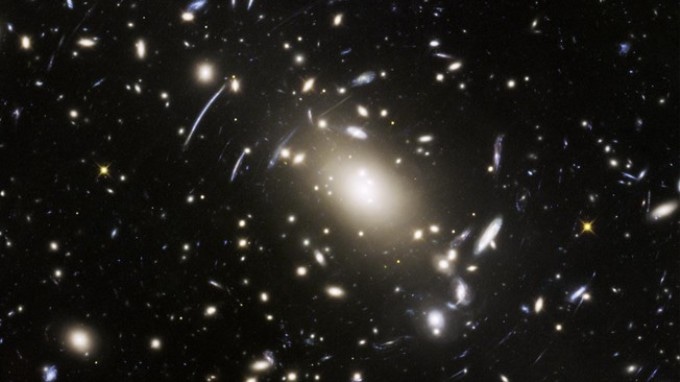Oct 26 2017
Galaxy clusters are the largest known structures in the Universe, containing thousands of galaxies and hot gas. But more importantly, they contain the mysterious dark matter, which accounts for 27 percent of all matter and energy. Current models of dark matter predict that galaxy clusters have very dense cores, and those cores contain a very massive galaxy that never moves from the cluster's center.
 Abell S1063, a galaxy cluster, was observed by the NASA/ESA Hubble Space Telescope as part of the Frontier Fields programme. The huge mass of the cluster acts as a cosmic magnifying glass and enlarges even more distant galaxies, so they become bright enough for Hubble to see. (Credit: NASA, ESA, and J. Lotz (STScI))
Abell S1063, a galaxy cluster, was observed by the NASA/ESA Hubble Space Telescope as part of the Frontier Fields programme. The huge mass of the cluster acts as a cosmic magnifying glass and enlarges even more distant galaxies, so they become bright enough for Hubble to see. (Credit: NASA, ESA, and J. Lotz (STScI))
But after studying ten galaxy clusters, David Harvey at EPFL's Laboratory of Astrophysics and his colleagues in France and the UK have discovered that the density is much smaller than predicted, and that the galaxy at the center actually moves.
Every galaxy cluster contains a galaxy that is brighter than the others, aptly named "brightest cluster galaxy" or BCG. Recent evidence from simulations of exotic, non-standard dark matter shows that BCGs actually wobble long after the galaxy cluster has relaxed. This is residual wobbling caused by massive merging of galaxy clusters.
The researchers compared their observations to the predictions from the BAHAMAS suite of cosmological hydro-dynamical simulations finding that the two did not match. According to the Standard Model of dark matter (called "cold dark matter"), this wobbling doesn't exist because the enormous density of dark matter keeps it tightly bound at the center of the galaxy cluster. Therefore, this mismatch suggests the existence of yet-unknown physics that have not been accounted for.
The galaxy clusters that the astronomers studied also act as strong gravitational lenses: they are so massive that they warp spacetime enough to distort light passing through them, like a lens. As a result, they can be used to make a map of dark matter, working out where the center is and then observing how the BCG wobbles around this center.
"We found that that the BCGs 'slosh' around at the bottom of the halos," says David Harvey. "This indicates that, instead of a dense region in the center of the galaxy cluster, there is a much shallower central density -- a striking signal of exotic forms of dark matter right at the heart of galaxy clusters." The wobbling also shows that BCGs cannot coincide exactly with the cluster's halo, meaning that certain models of galaxy clusters have to be adjusted.
The scientists will extend their research with larger surveys of galaxy clusters such as Euclid. They hope that this will allow them to confirm their findings, but to also determine if BCG wobbling originates in new fundamental physics or a novel astrophysical phenomenon.